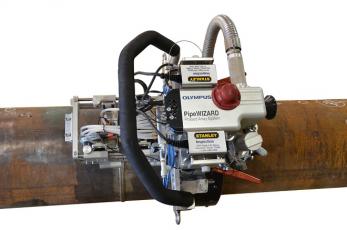
INTRODUCTION & BASIC INFORMATION
Pipelines perform a critical function in the global economy, transporting huge volumes of gas, oil, water, and other chemicals. Pipes are girth-welded on-site, typically using automated welding systems. For pipelines, welds are the “weak spot” as this is where defects tend to occur. Welds are nondestructively tested, coated, and buried or laid on the sea bed. Due to the demanding construction cycle, it is important that weld defects be detected and analyzed very quickly. Automated ultrasonic testing (AUT) has begun overtaking traditional radiography as the pipeline weld inspection method of choice throughout the world. Radiography has significant limitations: poor detection of planar defects, no vertical sizing capability, safety issues, and environmental concerns. The PipeWIZARD is an automated girth weld inspection system which is suitable for in-site weld-to-weld inspection in extreme environments. It uses conventional UT and phased array techniques. Electronic beamforming is used by phased arrays for producing and receiving ultrasound. The phased array systems are suitable for offshore and onshore pipeline construction projects. The PipeWIZARD system has resistance to electromagnetic interference, vibration and shock. Based on the pipe diameter, weld type, environment and location, the time of inspection cycle varies from 2 to 6 min. Defects detected by the PipeWIZARD system are incomplete penetration, burn through, porosity, lack of fusion, undercut, cold lap, hi-low, crack, inclusion, etc.
APPLICATION
AUT Zonal technique is widely used in oil & gas industries mainly for pipeline weld inspections. The PipeWIZARD system is versatile and allows the inspection of special weld configurations and applications like Cladded pipe, seamless pipe and thick pipes.